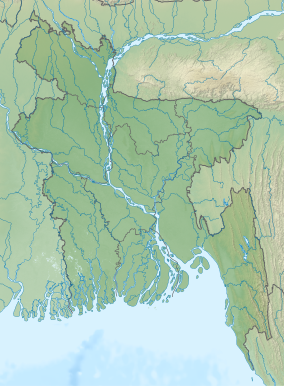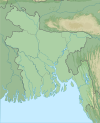|
Ramsagar National Park
 Ramsagar National Park (Bengali: রামসাগর জাতীয় উদ্যান) is a national park in Bangladesh located at. 25°33'00"N 88°37'30"E Tejpur, near Dinajpur District in the north-west of the country. The Park is 27.76 hectare, in size, and is built around a large water reservoir known as "Ramsagar tank". The lake is 1079m in length and 192.6m in width. The soil is red-yellow clay[1] HistoryThe tank was built in the 18th century by Raja Ram Nath.[2][3] It is believed that the lake was excavated by King Ramnath, Maharaja of Dinajpur before the Battle of Plassey.[1] The tank was dug by 15 million workers at a cost of 30,000 Taka. ManagementThe park is managed by 8 staff members which include 1 forest officers, 3 gardeners, 3 forest guards and 1 watchman.[4] It was first established in year 1960 and was earlier recommended that the park be developed as class-B national park for recreation and education by the Government of east Pakistan in 1971. It was declared as national park on 30-4-2001 under the Bangladesh wildlife (Preservation) Amendment Act of 1947.[5] Flora and FaunaThere are no big trees; the park consists of a big lake surrounded by embankments. Most of the flora and fauna are associated with wetland ecosystem. Flora272 plant species belonging to 132 families were recorded in this sanctuary. Mangifera indica, Syzygium cumini, Tamarindus indica, and Semecarpus anacardium are some of the trees found in the sanctuary.[4] FaunaThe lake is full of different types of fishes. There are turtles and snakes in the lake. The animals found here are Bengal fox, golden jackal, fishing cat and jungle cat. The water birds mainly consists of white breasted water hen, jacanas, river tern, kingfishers, ringed plover, grey heron and purple heron are found here.[4] The extinct animals of this park are Indian tiger, Indian leopard, Indian rhinoceros, Indian sloth bear, striped hyena, nilgai, Indian pangolin, Indian peafowl and many more. ThreatsThe plants inside the park are removed by the local villagers for food, fodder, making furniture, medicine and fuel. There is a decrease in the indigenous fish species due to overexploitation. The other factors affecting the biodiversity of the park are agricultural pollution, siltation, diseases and floods.[4] See alsoReferences
Wikimedia Commons has media related to Ramsagar National Park. |
||||||||||||||||

